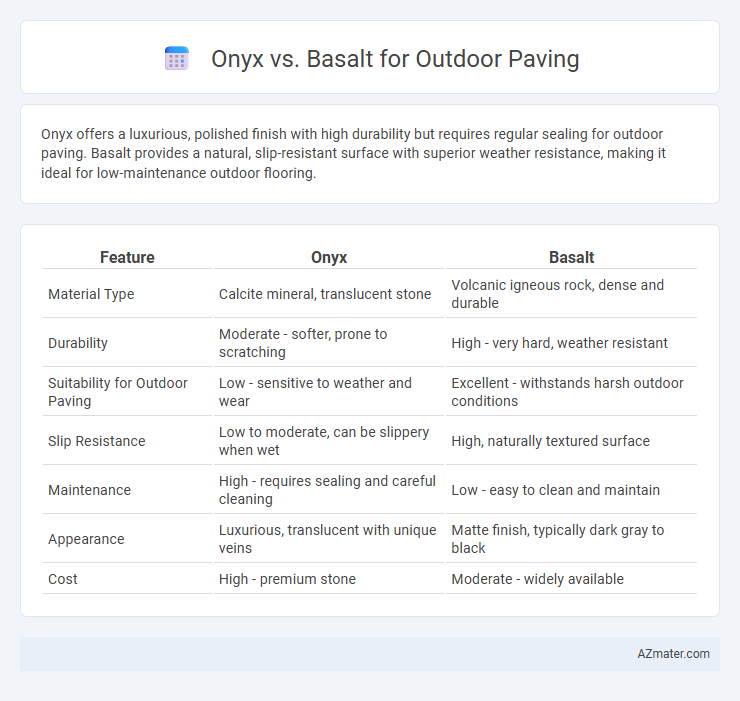Onyx offers a luxurious, polished finish with high durability but requires regular sealing for outdoor paving. Basalt provides a natural, slip-resistant surface with superior weather resistance, making it ideal for low-maintenance outdoor flooring.
Table of Comparison
| Feature | Onyx | Basalt |
|---|---|---|
| Material Type | Calcite mineral, translucent stone | Volcanic igneous rock, dense and durable |
| Durability | Moderate - softer, prone to scratching | High - very hard, weather resistant |
| Suitability for Outdoor Paving | Low - sensitive to weather and wear | Excellent - withstands harsh outdoor conditions |
| Slip Resistance | Low to moderate, can be slippery when wet | High, naturally textured surface |
| Maintenance | High - requires sealing and careful cleaning | Low - easy to clean and maintain |
| Appearance | Luxurious, translucent with unique veins | Matte finish, typically dark gray to black |
| Cost | High - premium stone | Moderate - widely available |
Introduction to Onyx and Basalt for Outdoor Paving
Onyx, known for its translucent beauty and unique veining, offers a luxurious aesthetic for outdoor paving but demands careful sealing due to its softer composition. Basalt, a dense volcanic rock, provides exceptional durability and slip resistance, making it ideal for high-traffic outdoor areas. Both materials present distinct visual appeal and functional benefits that influence their suitability for paving applications.
Geological Origins and Composition
Onyx, a form of chalcedony primarily composed of silica with distinct banded patterns, originates from volcanic lava flows where silica-rich solutions deposit in layers, creating its unique translucency and color variations. Basalt is an extrusive igneous rock formed from rapid cooling of basaltic lava at or near the Earth's surface, characterized by its dense, fine-grained texture and high iron and magnesium content. The geological origins impart Onyx with aesthetic appeal and translucency suited for decorative outdoor paving, while Basalt's durability and resistance to weathering make it ideal for high-traffic, functional paving applications.
Visual Appearance and Aesthetic Appeal
Onyx offers a striking, translucent quality with rich, vibrant colors and intricate veining patterns that create a luxurious, eye-catching outdoor paving surface. Basalt features a more uniform, matte finish with natural dark gray to black tones, providing a sleek, minimalist aesthetic that complements modern landscaping designs. Both materials enhance outdoor spaces, but Onyx stands out for its dramatic visual impact, while Basalt excels in subtle elegance and durability.
Durability and Weather Resistance
Onyx and basalt both offer exceptional durability for outdoor paving, with basalt's dense, fine-grained structure providing superior resistance to wear and heavy foot traffic. Basalt excels in weather resistance, maintaining its integrity against extreme temperatures, frost, and UV exposure, making it ideal for harsh climates. Onyx, while durable, is more prone to scratching and weather-induced discoloration, limiting its long-term performance in outdoor environments.
Slip Resistance and Safety Considerations
Onyx and basalt both offer strong slip resistance for outdoor paving, with basalt providing a naturally rough texture that enhances grip in wet conditions. Onyx, while visually striking, may require additional surface treatments or texturing to improve safety on slippery surfaces. Selecting basalt can reduce slip hazards and improve overall safety in high-traffic outdoor environments.
Installation Process and Maintenance Needs
Onyx pavers require professional installation with precise leveling and sealing to prevent surface staining and weather damage, making the process moderately intensive. Basalt, known for its natural durability and rough texture, allows for easier installation with less sealing but demands regular cleaning to avoid moss growth in damp conditions. Both materials benefit from periodic maintenance, though Onyx's polished finish needs more frequent sealing compared to Basalt's rugged surface.
Cost Comparison: Onyx vs Basalt
Onyx outdoor paving tends to be more expensive than basalt due to its rarity and aesthetic appeal, often costing 20-30% more per square foot. Basalt offers a cost-effective alternative with competitive durability at a lower price point, making it suitable for large-scale projects with budget constraints. Installation costs for both materials can vary, but basalt requires less specialized handling, contributing to overall savings.
Eco-Friendliness and Sustainability Factors
Onyx and basalt differ significantly in eco-friendliness and sustainability for outdoor paving. Basalt is a natural volcanic rock with high durability and low maintenance, making it a sustainable choice due to its long lifespan and minimal need for replacement. Onyx, although visually striking, is less abundant and often requires intensive quarrying processes, which may increase its environmental impact compared to basalt's more eco-friendly extraction and use.
Ideal Outdoor Applications for Each Stone
Onyx offers a luxurious appearance with its translucent layers and vibrant colors, making it ideal for decorative outdoor pathways, patios, and accent areas where visual appeal is a priority. Basalt's durability, slip resistance, and weather-resistant properties suit high-traffic outdoor applications such as driveways, walkways, and pool surrounds that require strength and low maintenance. Selecting onyx enhances aesthetic outdoor spaces, while basalt provides a practical, long-lasting solution for functional outdoor paving.
Summary: Choosing the Right Stone for Your Outdoor Project
Onyx offers a stunning, translucent aesthetic ideal for decorative outdoor features but lacks the durability needed for high-traffic paving. Basalt provides superior strength, weather resistance, and slip resistance, making it the optimal choice for outdoor paving projects exposed to harsh conditions. Selecting between Onyx and Basalt depends on balancing visual appeal with functional longevity, where Basalt generally outperforms for practical outdoor applications.

Infographic: Onyx vs Basalt for Outdoor Paving
 azmater.com
azmater.com